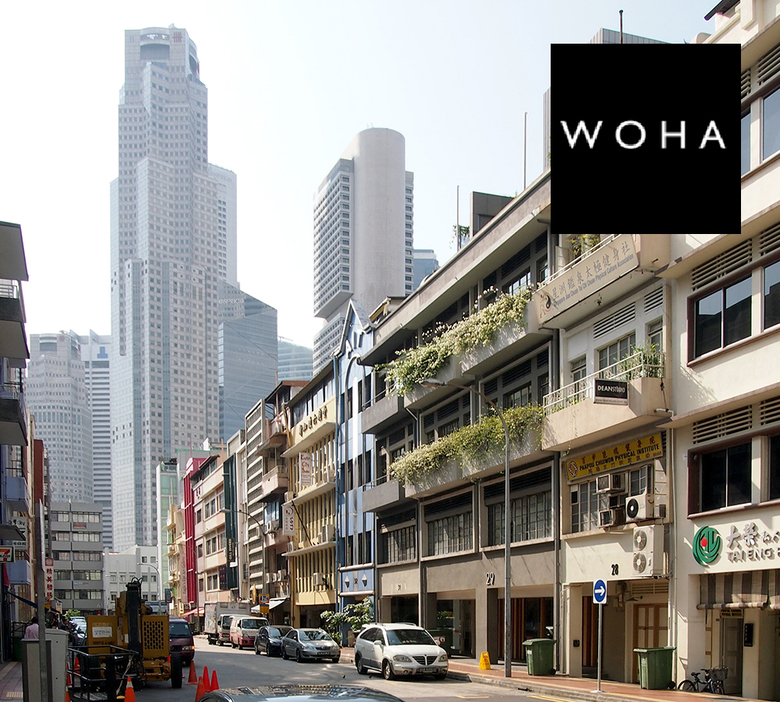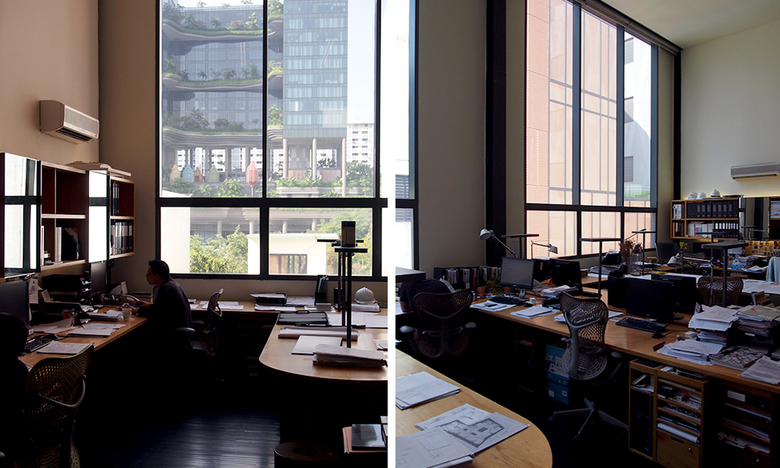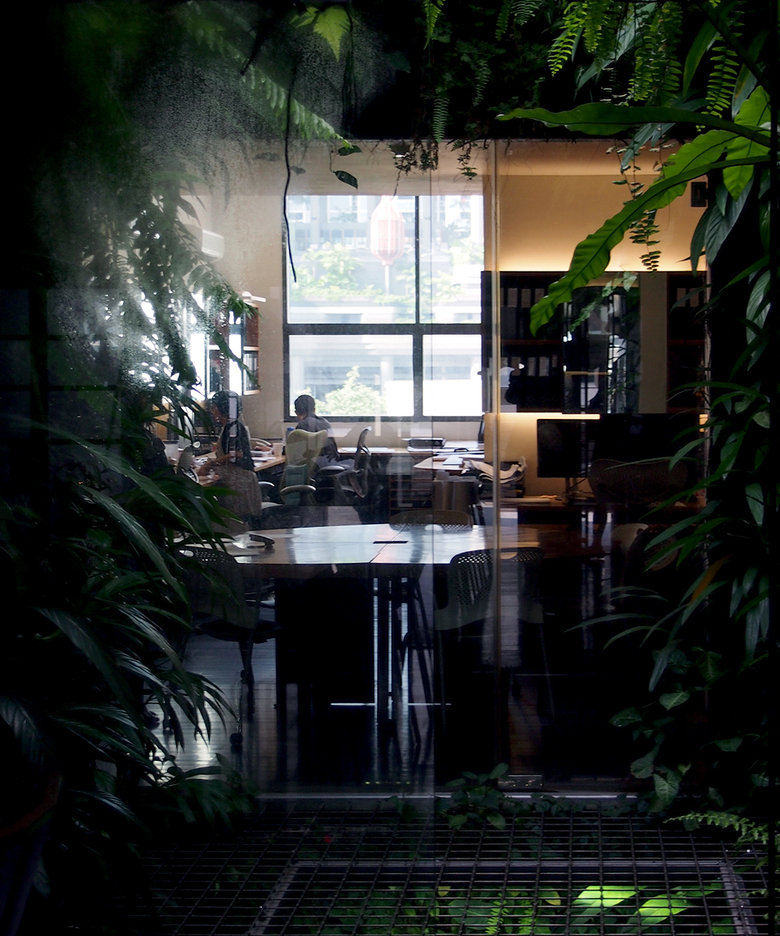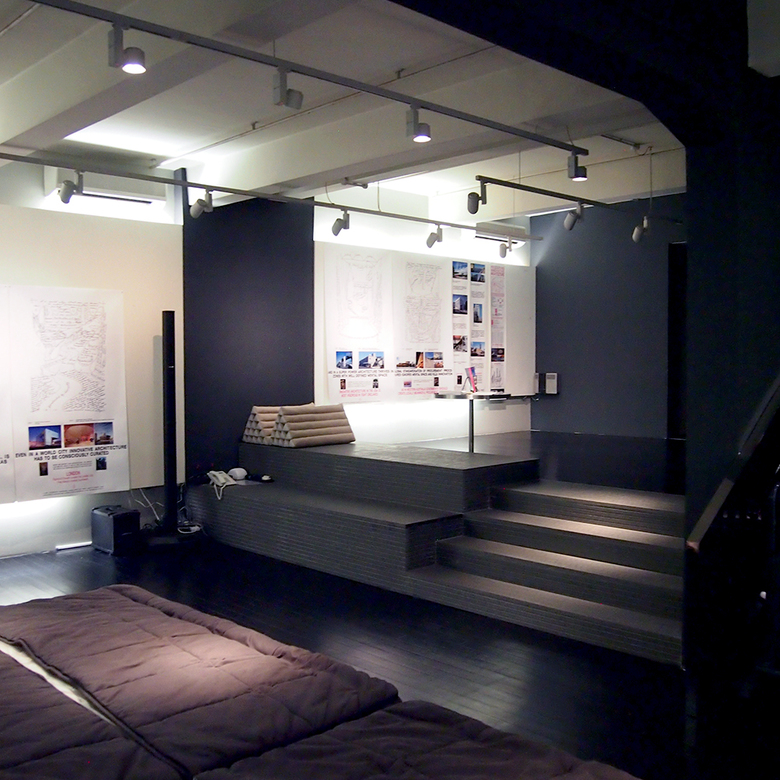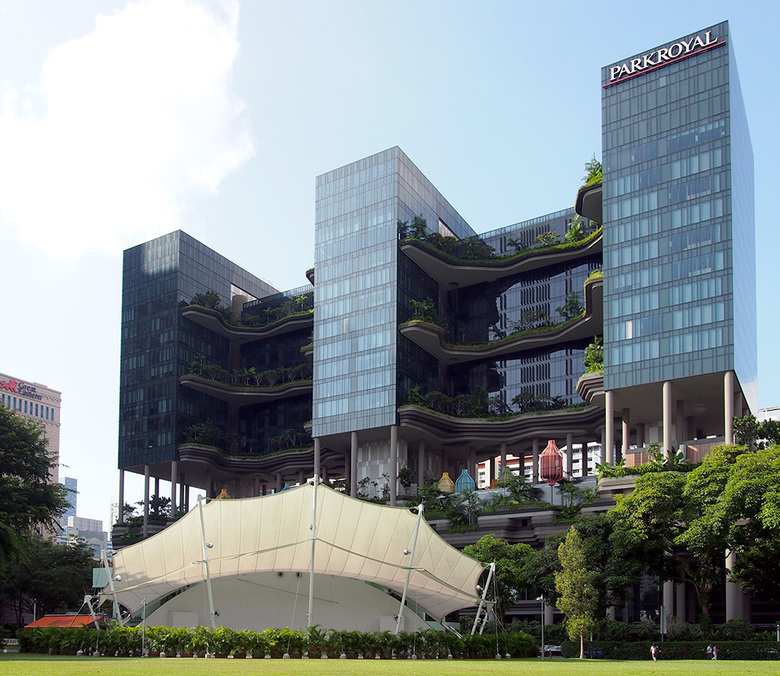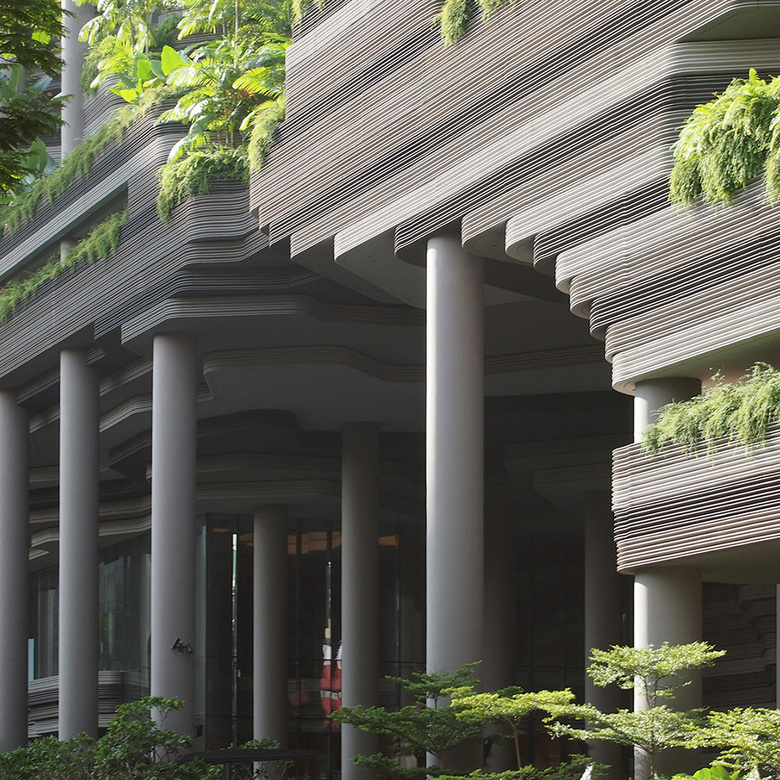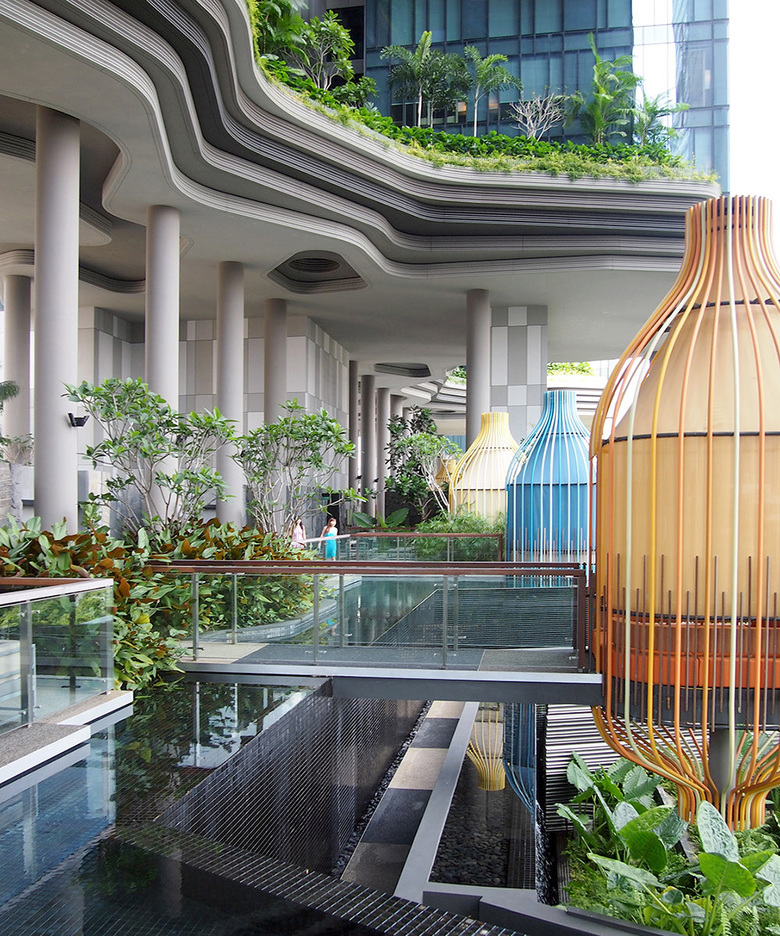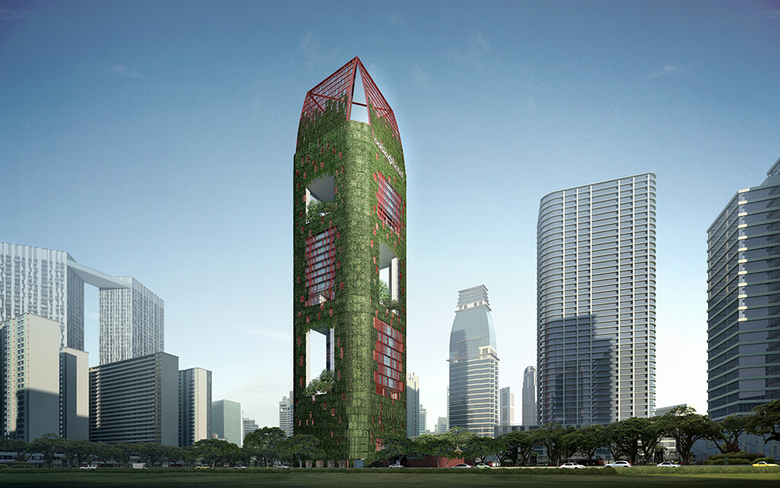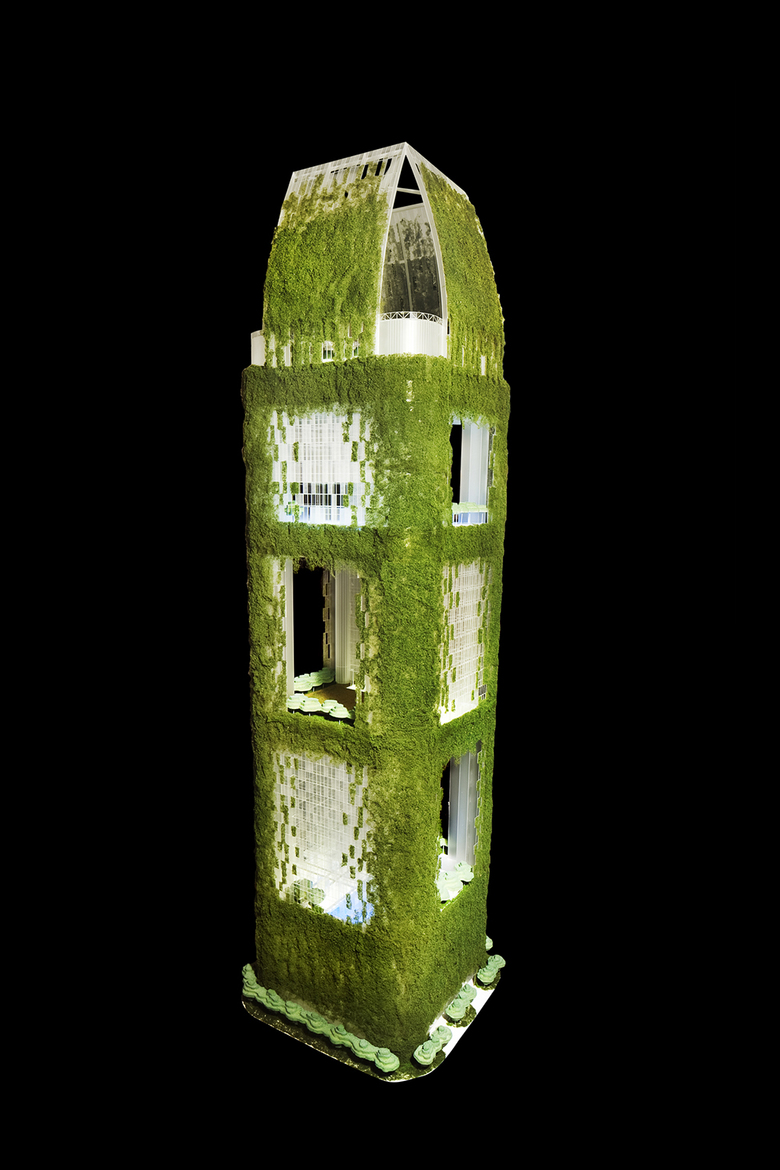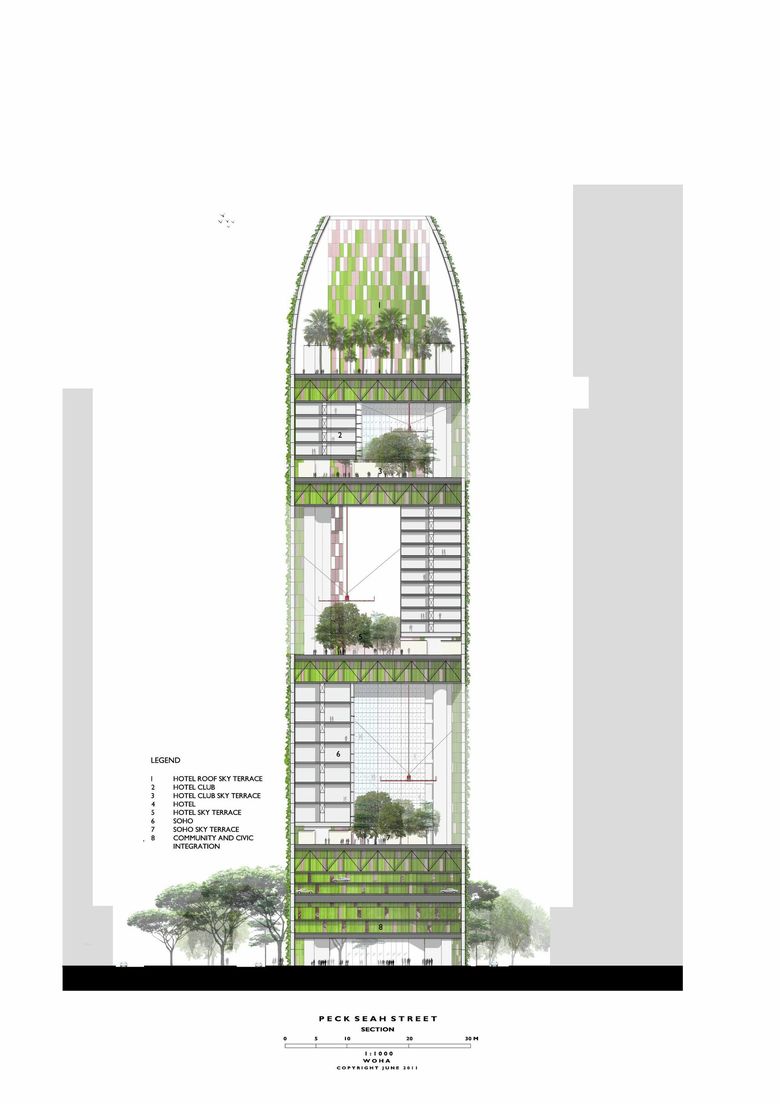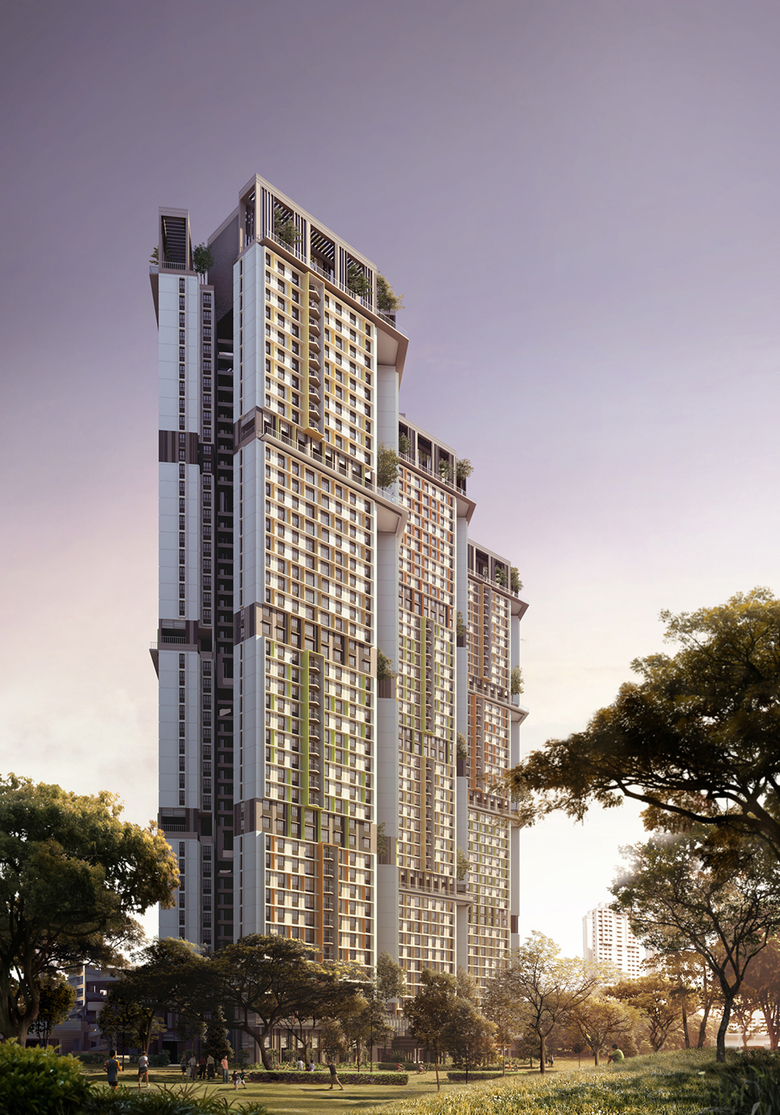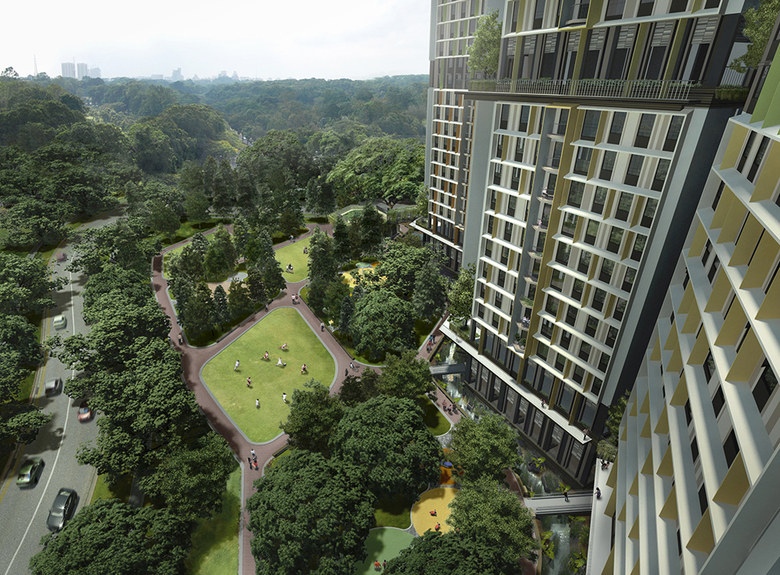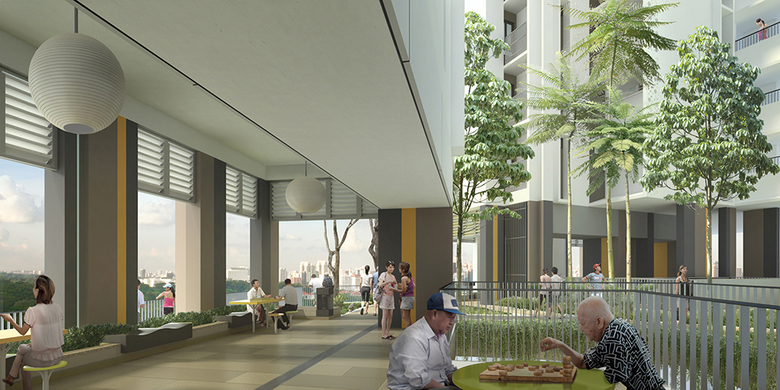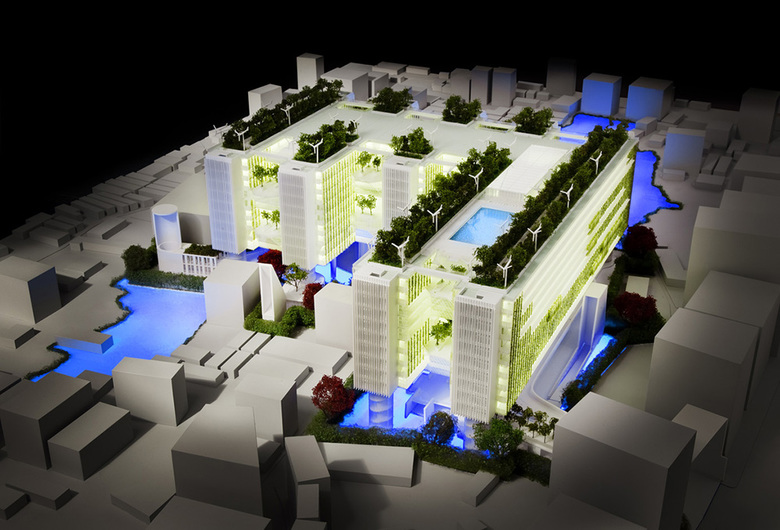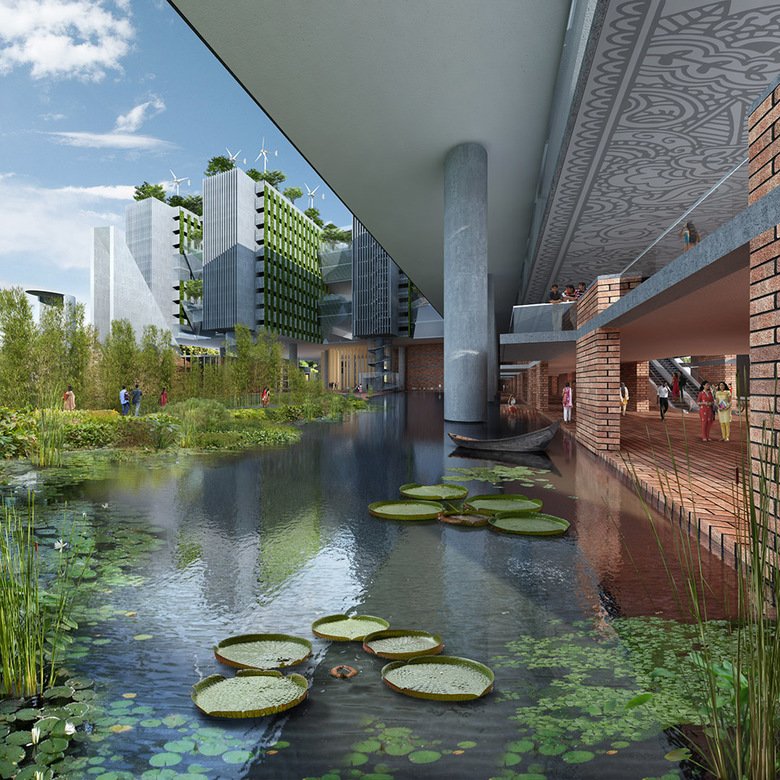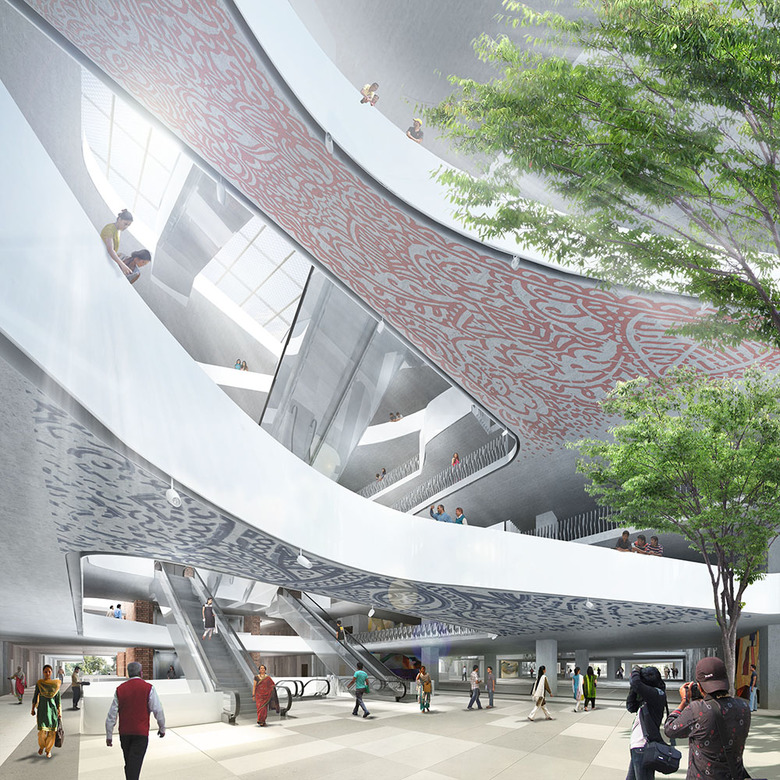Studio Visit: WOHA
While in Singapore for the 2013 World Architecture Festival, World-Architects visited local firm WOHA to check out their five-story office, chat about some of their projects in the city, and look at some in-progress projects. Here is our report.
Two of their projects—PARKROYAL on Pickering and 48 North Canal Road—were shortlisted for WAF awards and were found within steps of WOHA's office. This provided the fortunate ability to visit both their studio and their buildings in one day. Below is an account of our visit to their office and one of the nearby buildings, as well as a peek at a few projects underway.
On the first day of WAF we headed to one of the crit rooms to listen to WOHA's presentation of their 48 North Canal Road project—shortlisted in the Office Category—but we were confronted with a crowd overflowing from the room into the hallway. From our vantage point at the back of the throng assembled to listen to the local favorites, we could see the slides but not hear the architects explain the building.
Luckily the next morning we were able to stop by WOHA's office, which sits at 29 HongKong Street, just one block north of the office building they presented the day before. After outgrowing their previous space WOHA moved into the five-story building in 2007, combining two buildings and renovating the interior.
Singapore is a clean and civilized place, but like any city a good amount of energy comes from its more than 5 million residents. So the first feeling on stepping into WOHA's ground-floor lobby was tangible: calm. The combination of dark-steel walls, paintings by Richard Hassell, and artifacts from Bali and other places (including a striking whale bone) creates a strong transition from the activity of the city to the focused environment of the office.
From ground floor to top floor the stacking of the five floors works like this: lobby and conference rooms are on the ground floor; the public gallery and administrative offices are on the next floor; architecture studio and directors' offices/library are on the floor above; and on the next two floors are interiors and architecture studios. The top floor also features a roof terrace for dining, and above that again is a vegetable garden that is in progress and is an obvious extension of the vertical green environments WOHA is known for.
Tying the five floors together is a small, central light well that is lined with creeping plants on the sides. This green void sits adjacent to the elevator and the corridor that connects rooms on the front of the building to those on the back, meaning that any movement in the building—horizontal or vertical—takes place alongside the light well. The space, though glassed off (it is accessible for service, with mesh netting at each level), has a cooling effect while also reinforcing the calming sensation of the whole interior.
This calm extends to the second-floor public gallery, which sits behind panels that can slide open to visually connect the space with HongKong Street. On my visit the drawings and analysis of RMIT's Leon van Schaik (Hassell's old professor) were on display in the space. I could envision the gallery being a respite for the public but also a place for employees to get away to for a few minutes each day.
On the afternoon of the second day of WAF, WOHA presented their PARKROYAL on Pickering—shortlisted in the Hotel Category. We were able to stop by the hotel on the way to their office and then ask them a few questions about the project and how it relates to their larger portfolio of increasingly larger and greener projects. PARKROYAL is part of their ongoing research with vertical greening and sustainable, high-density developments.
"As our cities become more developed and built-up, they should not become all hard edges, glass and concrete," they explained. "We want to integrate softness using gardens and greening, which is not only environmentally positive but also adds delight and relief for building users, passers-by and other city dwellers." It's hard to deny this argument, considering how PARKROYAL appears to be a vertical continuation of Hong Lim Park to the south. The architects recounted one measure of its success: "We have heard of taxi drivers taking their customers past the PARKROYAL on Pickering just to show it off!"
In a point that WOHA would reiterate in their WAF presentation on PARKROYAL, the architects explained to me how they try to "give back" greenery when a building occupies a site, typically in a 1:1 ratio—a 100% green replacement. In the case of the hotel they exceeded that goal: "This project achieves 215% green replacement, so there is more than twice as much plants as if the site was left vacant, and in fact there is as much green in the building as in the park across the road." This startling number comes from the trios of "U"-shaped terraces found in the buildings upper floors and the bits of vegetation inserted at the base of the building (below), but mainly from the fact that the fifth floor—a public plaza and pool for hotel guests—covers the footprint of the site and is home to many plants and trees.
Singapore's tropical location just 1 degree north of the equator makes it ideal for thriving greenery. But its compact, island geography points to some impediments that WOHA is trying to overcome through PARKROYAL and their other high-density, vertical-green projects: "The island is so small, flat and with very uniform sites and planning controls, so projects tend to have a similarity in scale and type across the island. It is also centrally planned so there is little variation across the city. We feel this lack of diversity of options for families can be countered with buildings that can incorporate more diversity."
Integrating green space across tall buildings is definitely an important part of this goal: "To us tropical architecture will continue to evolve in interesting and different ways in tandem with the way we live our lives. As our cities become more dense, more and more people live and work in high-rise buildings; the challenge will be how to integrate climactic solutions that provide comfort, reduce or eliminate dependence on air-conditioning and address other urban issues such as providing spaces for interaction, community building and greenery. Our upcoming hotel project in Singapore, the Oasia Downtown currently under construction in the heart of the Central Business District, has a green-plot ratio of 750%! "
With this stated goal for Oasia Downtown, here we look at that project and a couple more that WOHA is currently working on—a public housing project in the city and a university in Bangladesh. The following text and images are courtesy of WOHA.
Estimated completion: March 2015
Oasia Downtown sets out to create an alternative imagery for commercial high-rise developments. It combines innovative ways to intensify land use with a tropical approach that showcases a perforated, permeable, furry, verdant tower of green in the heart of Singapore’s Central Business District (CBD).
In programmatic response to the client’s brief of having distinct SOHO, Hotel & Club rooms, WOHA adopted a club sandwich approach by creating a series of different strata, each with its own sky garden. Introducing layers of elevated ground levels allows the precious but limited ground floor space to be multiplied, creating generous public areas for recreation and social interaction throughout the high-rise.
Sited within a densely built up area, the tower carves out its own internal spaces and dynamic views instead of relying on external vistas for visual interest. Each sky garden is treated as an urban scale verandah, sheltered at high level by the preceding sky garden and open sided for formal and visual transparency. The openness also allows wind to pass through the building for good cross-ventilation. Large-scale High Volume Low Speed (HVLS) fans are incorporated as kinetic sculptures that complement the sky garden design and ensure thermal comfort. In this way the public areas become functional, comfortable tropical spaces with greenery, natural light and fresh air instead of enclosed, internalized air-conditioned spaces.
Landscaping is used extensively as an architectural surface treatment and forms a major part of the development’s material palette both internally and externally, achieving an overall Green Plot Ratio of 750%. The building form is softened by a living green façade of creepers and flowering plants, creating an alternative image distinct from the surrounding glassy towers of the CBD, one that is tropical, urbanistically sensitive and humanistic.
Estimated completion: February 2015
Skyville @ Dawson is a public housing project of 960 homes in Singapore, commissioned by the Housing and Development Board as an exploration of the future of affordable public housing. It was exhibited to the public, enthusiastically received, and is under construction. The design focuses on three themes – variety, community, and sustainability.
Variety: The design gives variety by offering buyers flexible floor plans with a column-free, beam-free main space, eliminating waste and allowing diverse lifestyles, such as home office or loft living as well as future flexibility. Three versions of each type were offered.
Community: There is a variety of community space. Each home is part of a Sky Village: 80 homes that share a naturally ventilated community terrace and garden. The block is composed of 3 villages, stacked 4 high, for a total of 12 villages. Other community areas include: the Community Living Rooms at ground level, which provides seating areas overlooking the park, and are located on the main entrance route of the development; the Landscaped Park, which retains enormous historic rain trees and provides two community pavilions for weddings and funerals, play and fitness areas, courts and lawns; the Rooftop Park, which houses a 400m jogging track and rooftop pavilions which support a PV array that powers the common lighting; the Urban Plaza, located along a public linear park and provides supermarket, coffee shop and retail spaces.
Sustainability: The design has been awarded Singapore’s Platinum rating, the highest rating possible. The project uses passive means and avoids the use of energy-intensive solutions rather than using high technology. Every unit is fully naturally ventilated, with every room (including bathrooms and kitchens) having windows. The common areas, lift lobbies and access walkways are all naturally ventilated and lit. The apartments are cross ventilated, with CFD simulations performed at the block and unit level. The units use passive means for comfort: all walls have vertical and horizontal sun-breakers to shade both the walls and the windows, all windows have overhangs and special mid-height top hung panels that direct breeze to seating height and allow the windows to remain open during the monsoon period, the units face north and south, and have openings on all sides.
BRAC University, Dhaka, Bangladesh
Estimated completion: N/A
Amongst the densest and harshest megalopolises in the world, Dhaka's rapid urbanization and overcrowding has resulted in the displacement of the city's water bodies, vegetation, open and civic spaces by buildings and industries. Sited on an urban lake, the vision is to present an innovative and sustainable inner city campus that exemplifies tropical design strategies in response to the hot, humid, monsoon climate of the region while demonstrating the sensitive integration of nature and architecture.
Drawing inspiration from the Bengal basin's Sundarbans mangrove forest that have separate ecosystems above and below tidal level, the design strategy is to create two distinct programmatic strata by floating the Academia above the lake and revealing a Campus Park below, thus reflecting the synergistic coexistence between mankind and mangrove. This approach minimizes the building’s footprint over the lake, and through the introduction of multiple elevated ground levels including a Student Forum and a rooftop recreational University Green, further maximizes space for facilities while opening up the ground level to activity generating interaction spaces and effective additional park land that creates an imageable milieu for a vibrant campus life.
At its heart, this is a campus set in a park—a lush green oasis offering much needed refreshment and inspiration under a canopy of learning. Through perforating the building form with breezeways, porous facades and garden terraces, and by sculpting the building section to direct breezes to sheltered gathering spaces, the campus is designed to breathe, with cross ventilation and indirect natural daylighting making tropical learning spaces without air-conditioning. A cost effective and robust aesthetic that promotes the use of local materials, traditional crafts/skills and vegetation forms the building's material palette. Landscaping applied vertically and horizontally exemplifies the potential in multiplying greenery and open spaces within a dense, urban site and sets the direction that must be embraced to make Dhaka a modern, livable, sustainable and humane city.
Related articles
-
-
-
Center for Inclusive Growth & Competitiveness for TAPMI
The Purple Ink Studio | 27.10.2025
